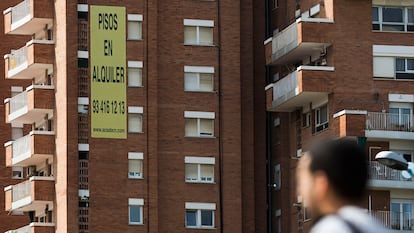Average cost of rent in Spain falls for the first time since financial crisis
Rental prices have dropped as a result of the coronavirus crisis which has pushed more tourist apartments onto the market, leading to a surplus of supply


The fall in rent prices is no longer a big-city phenomenon in Spain. For the first time in years, the average cost of rent in the country is either on a downward trend or stagnating. This January, the coronavirus pandemic ended a growth streak that had been uninterrupted since July 2015, according to real estate website Fotocasa, and since June 2014, according to property website Idealista. This makes it the first drop recorded since the 2008-2014 financial crisis in Spain. Meanwhile, in the big cities, rental prices continue to fall.
The real estate portals Fotocasa, Idealista and Pisos.com began to record a drop in the cost of rent in Spain’s main cities in the early stages of the pandemic. Each month, rent became cheaper, and this began to be reflected in the national average. But in year-on-year terms, the cost of rent in any given month was still higher than it was in the same month of the previous year. Now, in 2021, this no longer holds true: the Spanish average of €11 per square meter that Idealista recorded as the asking price last January is 0.1% less than 12 months earlier. It is not a big drop, but it is significant as it is the first time this has happened since June, 2014, according to Idealista.
A recent study found that the number of properties available for rent in Spain soared last year by 178%
Data provided by the portals Fotocasa and Pisos.com reflect the same trend. According to Fotocasa, in January the average cost of rent stagnated (0%), after growing continuously for 65 months. Meanwhile, the most dramatic fall in price was noted by Pisos.com – a 1.8% fall in year-on-year terms, although it already pointed in November to a slight drop of 0.1%.
In the case of all three portals, the January data is a turning point as December showed the average cost of rent ending 2020 higher than they started the year, despite the pandemic. However, the fact that the websites note the asking price and not the price at which the contract is closed should also be taken into account. As Gonzalo Bernardos, director of the Real Estate Masters course at the University of Barcelona, points out, these prices “reflect upward trends more accurately than downward trends.” He believes that real prices may have started to fall months ago.
According to Bernardos, one of the reasons for the plummeting prices is a surplus in supply. A recent study by Casafari, a portal with a large property index aimed at professionals and companies, found that the number of properties available for rent in Spain soared last year by 178%. The authors of the report point out that this was mainly due to the number of tourist apartments that were placed on the traditional rental market. With coronavirus restrictions on travel, the number of tourists to Spain fell dramatically last year, meaning there was less demand for holiday rentals.
Add to this the fact that many families are having economic difficulties. “If you are suddenly on an ERTE furlough scheme, you realize you need to pay less,” says Lázaro Cubero, director of analysis at real estate firm Tecnocasa Group. “Many people have left the property they were renting in exchange for something cheaper and during the first lockdown we detected a shift in a number of cities on account of this.”
There are also people looking for larger homes to accommodate their remote working requirements. “A number of people are looking to pay the same price, but for more space,” says Cubero. Both experts believe that these factors are consistent with the changes the portals have flagged up, with prices tumbling first in the big cities, which receive more tourists, people traveling for work and students.
Significant drops
Bernardos points out that the cost of rent will consequently not go down that much in smaller cities. “In the average regional capital, the discrepancy between [the cheapest and most expensive] rents may be 30%, but in Barcelona or Madrid there is a 200% difference between the most expensive and the cheapest areas,” he says. In other words, the cost of rent in Madrid and Barcelona has further to fall because they the cities “have the largest surplus of rental properties since the advent of democracy.”
Data from the real estate portals in January indicate that the main fall in prices is concentrated in cities with more than half a million inhabitants. In Barcelona, all three websites record a double-digit decline in the cost of rent compared to 12 months ago. In Madrid, where rent has also been falling month to month since mid-2020, the cost of rent is already 8.6% less than last January, according to Idealista, the portal which recorded the smallest fall. The biggest drop of all was recorded in the southern city of Seville, where the cost of rent fell 14.78%, according to Pisos.com.
All the data point to significantly lower prices, a phenomenon that even the Aragon capital, Zaragoza, is subject to. In fact, compared to December, prices fell in all major cities, with the sole exception of Valencia, according to Fotocasa data, which reported a slight monthly increase of 0.1%, though the year-on-year cost of rent is still 7.4% cheaper, according to the same figures. Zaragoza and Valencia, as well as being the cities that have recorded the smallest drops, are also the ones with the cheapest average rents, according to all three portals.
A number of people are looking to pay the same price, but for more spaceLázaro Cubero, director of analysis at Tecnocasa Group
The fact that the falls are continuing to accelerate in the big cities shows that there is still some way to go before the prices bottom out, according to experts. “The economic issues are not going to be solved this year,” Cubero points out. “Hopefully, the health issue will be solved, and logically that would mean the downward trend continuing. There is very little chance that the opposite will happen, but from then on, if everything goes well, the decline will begin to slow.”
Cubero also points out that the recovery will be reflected in the rental market before the sales market as happened when the coronavirus crisis first began to affect the property market. “Renting is more agile and these trends are seen sooner,” he explains. “If a tenant decides they want to move house, they do so in two months.”
Meanwhile, Bernardos points out that before the rental market rebounds, several signs will become evident. “First landlords will notice they can rent their properties faster and then, the next step, will be a rise in prices,” he says, though he does add that there will probably be lower prices for some time to come. “In 2022, the price will continue to fall because the surplus will still have to be absorbed,” he says. “We have seen the market plummet because of oversupply, which is a novelty, and then a rise in prices will follow, but much more slowly.”
English version by Heather Galloway.
Tu suscripción se está usando en otro dispositivo
¿Quieres añadir otro usuario a tu suscripción?
Si continúas leyendo en este dispositivo, no se podrá leer en el otro.
FlechaTu suscripción se está usando en otro dispositivo y solo puedes acceder a EL PAÍS desde un dispositivo a la vez.
Si quieres compartir tu cuenta, cambia tu suscripción a la modalidad Premium, así podrás añadir otro usuario. Cada uno accederá con su propia cuenta de email, lo que os permitirá personalizar vuestra experiencia en EL PAÍS.
¿Tienes una suscripción de empresa? Accede aquí para contratar más cuentas.
En el caso de no saber quién está usando tu cuenta, te recomendamos cambiar tu contraseña aquí.
Si decides continuar compartiendo tu cuenta, este mensaje se mostrará en tu dispositivo y en el de la otra persona que está usando tu cuenta de forma indefinida, afectando a tu experiencia de lectura. Puedes consultar aquí los términos y condiciones de la suscripción digital.
More information
Últimas noticias
Most viewed
- Sinaloa Cartel war is taking its toll on Los Chapitos
- Oona Chaplin: ‘I told James Cameron that I was living in a treehouse and starting a permaculture project with a friend’
- Reinhard Genzel, Nobel laureate in physics: ‘One-minute videos will never give you the truth’
- Why the price of coffee has skyrocketed: from Brazilian plantations to specialty coffee houses
- Silver prices are going crazy: This is what’s fueling the rally










































